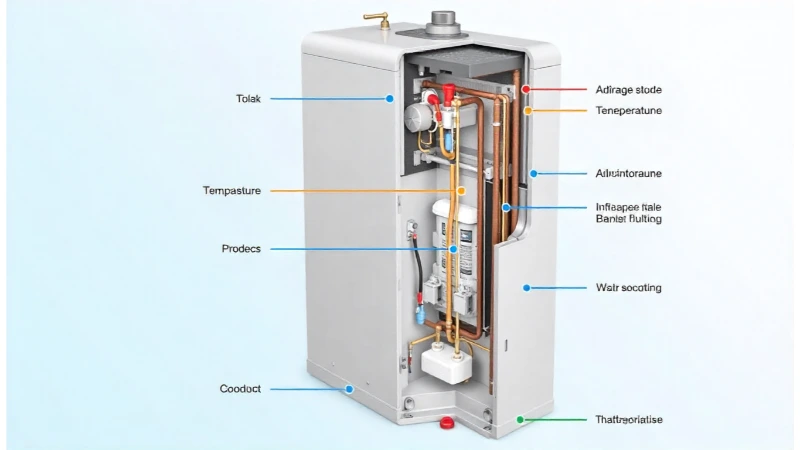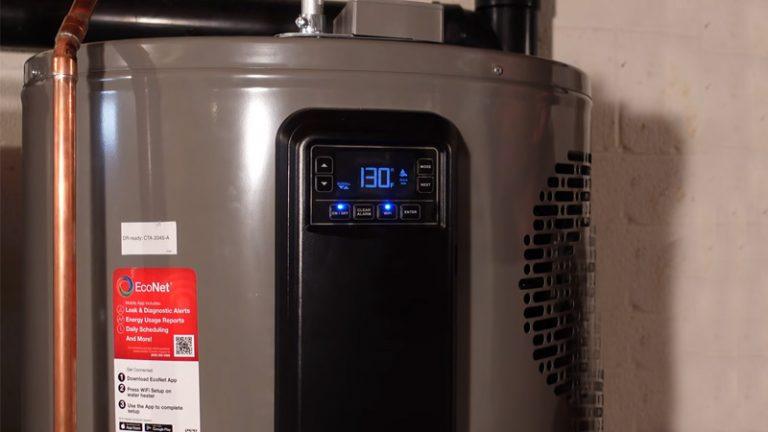Navien Tankless Water Heater Temperature Woes? Your Fix is Here
There’s nothing more frustrating than stepping into a shower expecting consistent, hot water, only to be met with unpredictable temperature swings. A sudden blast of cold water or a surge of scalding heat can ruin your day. If you’re experiencing Navien tankless water heater temperature fluctuation, you’re not alone, and more importantly, there are solutions.
This comprehensive guide will walk you through the common culprits behind this annoying problem and provide actionable steps to restore your hot water harmony. From simple checks to more involved troubleshooting, we’ll cover everything you need to know. Say goodbye to inconsistent showers and hello to reliable, on-demand hot water.
You'll Learn About
Decoding the Fluctuation: Why Your Navien’s Temperature is Unstable
Understanding the root cause is the first step toward a solution. Several factors can contribute to the frustrating temperature swings you’re experiencing with your Navien unit. Identifying the specific issue is key to implementing the right fix.
From water flow issues to mechanical component failures, the reasons for temperature instability can be varied. Let’s explore the most common culprits in detail. This will help you diagnose the problem accurately and efficiently.
The “Cold Water Sandwich” Effect
One of the most common complaints with tankless water heaters is the “cold water sandwich.” This occurs when you briefly turn off the hot water and then turn it back on. You get an initial burst of hot water (leftover in the pipes), followed by a slug of cold water before the heater has a chance to fire up and deliver hot water again.
This phenomenon happens because the tankless unit needs a moment to detect the water flow and ignite the burner. While Navien’s ComfortFlow® technology, which includes a small buffer tank, is designed to minimize this, it can still occur under certain conditions.

Insufficient Water Flow Rate
Navien tankless water heaters require a minimum flow rate to activate and maintain operation. If the flow of water through the unit is too low, the burner may shut off, leading to a drop in temperature. This is a common issue in showers with low-flow showerheads or when only a small amount of hot water is being drawn.
You might notice that the temperature is stable when a bathtub faucet is running full blast but fluctuates during a shower. This points directly to a flow rate issue. The heater simply isn’t getting the signal it needs to stay on and continuously heat the water.
Faulty or Dirty Flow Sensor
The flow sensor is a critical component that detects water movement and tells the unit to start heating. If this sensor is dirty, corroded, or malfunctioning, it can send inaccurate signals to the control board. This can cause the heater to cycle on and off unexpectedly, resulting in temperature swings.
Mineral buildup from hard water is a frequent cause of flow sensor problems. Over time, these deposits can impede the sensor’s ability to function correctly. Regular maintenance, including descaling, is crucial to prevent this issue.
Your Action Plan: How to Fix Navien Temperature Fluctuations
Now that you have a better understanding of the potential causes, it’s time to take action. The following steps will guide you through the troubleshooting process, from simple checks to more advanced solutions. Always prioritize safety by turning off the power and gas supply to the unit before performing any maintenance.
By systematically working through these solutions, you can identify and resolve the issue causing your Navien tankless water heater’s temperature fluctuations. A little bit of effort now can lead to years of consistent and reliable hot water.
Step 1: Basic Checks and Simple Fixes
Start with the easiest potential solutions first. Check your water and air filters for any blockages. A clogged filter can restrict flow and cause the unit to malfunction. Clean or replace the filters as needed according to your user manual.
Also, ensure that your main gas supply valve is fully open. An inadequate gas supply can lead to ignition failures and temperature inconsistencies. These simple checks can often resolve the problem without the need for more extensive repairs.
Step 2: Address Water Flow Issues
If you suspect a low flow rate is the problem, there are a few things you can try. First, try running another hot water tap simultaneously, like a nearby sink, to increase the overall flow through the heater. If this stabilizes the shower temperature, you’ve confirmed a flow rate issue.
Consider cleaning or replacing your showerhead to remove any mineral buildup that might be restricting flow. If the problem persists, you may need to consult a plumber about adjusting your plumbing to ensure the heater receives the minimum required flow rate.
Step 3: Cleaning and Maintaining the Flow Sensor
If you’re comfortable with some light mechanical work, you can attempt to clean the flow sensor. You’ll need to locate the sensor (refer to your manual) and carefully remove it. Gently clean any visible corrosion or debris from the sensor.
For a more permanent solution, consider upgrading to a stainless steel flow sensor, which is more resistant to corrosion. Regular descaling of your unit is also essential to prevent future buildup on the flow sensor and other internal components.
Step 4: Check for Gas Pressure Problems
Incorrect gas pressure can wreak havoc on your tankless water heater’s performance. Low gas pressure can cause the burner to not ignite properly or to shut off intermittently. Conversely, excessively high pressure can also cause problems.
Checking and adjusting gas pressure is a job for a qualified professional. Do not attempt to do this yourself. A technician will have the proper tools, like a manometer, to ensure the gas pressure is within the manufacturer’s specified range.
| Problem | Potential Cause | Solution |
|---|---|---|
| Sudden cold blasts (Cold Water Sandwich) | Heater turning on and off between uses | Install a recirculation system or a small buffer tank. Some Navien models have this built-in. |
| Temperature drops during low-flow use (e.g., shower) | Insufficient water flow rate | Clean or replace low-flow fixtures. Run another hot water tap to increase demand. |
| Heater cycles on and off repeatedly | Dirty or faulty flow sensor | Clean the flow sensor. Descale the unit regularly. Consider replacing the sensor. |
| Inconsistent heating and potential error codes | Improper gas pressure | Contact a qualified technician to check and adjust the gas pressure. |
| Lukewarm water or failure to reach set temperature | Mineral buildup in the heat exchanger | Perform a descaling/flushing of the unit as part of regular maintenance. |
Advanced Troubleshooting and When to Call a Pro
If you’ve worked through the steps above and are still experiencing Navien tankless water heater temperature fluctuation, it may be time to consider more complex issues. Sometimes, the problem lies with the internal components of the unit itself. It’s also possible that you’re facing other issues, like those found in a GE Cafe refrigerator with temperature problems.
In these cases, it’s often best to call a qualified technician who is experienced with Navien products. They have the diagnostic tools and expertise to pinpoint the problem accurately and safely. Trying to address complex issues on your own could void your warranty or lead to further damage.
DIP Switch Settings and Recalibration
Your Navien unit has a series of DIP switches on the main control board that control various functions. Incorrect settings can sometimes lead to performance issues. While your manual will have information on these settings, it’s generally best to have a technician verify them, especially if you suspect they’ve been tampered with.
In some instances, a technician may be able to recalibrate certain settings to better suit your home’s specific plumbing configuration. This can sometimes help to smooth out temperature fluctuations, especially in homes with unusual plumbing layouts.
Potential Control Board Failure
While less common, a failing control board can cause a wide range of issues, including erratic temperature control. If your unit is shutting on and off for no apparent reason, it could be a sign of a control board problem. Similar to the complex electronics in a modern appliance, like those that can lead to GE refrigerator temperature control problems, the control board is the brain of the operation.
Diagnosing and replacing a control board is a job for a professional. They can confirm if the board is indeed the issue and install a new one correctly. This is not a DIY-friendly repair.
Considering Other Appliance Issues
While focused on your water heater, it’s sometimes helpful to think about how other appliances function. For instance, if you’ve ever dealt with Electrolux refrigerator temperature problems, you know that a single faulty sensor can throw the entire system off. The same principle applies to your Navien water heater.
By keeping a maintenance mindset for all your home appliances, you can often prevent major issues before they start. Regular servicing and being aware of the early signs of a problem can save you a lot of hassle and expense in the long run.
Preventative Maintenance: The Key to Consistent Hot Water
The best way to deal with Navien tankless water heater temperature fluctuation is to prevent it from happening in the first place. Regular maintenance is crucial for the longevity and performance of your unit. Just like changing the oil in your car, proactive care for your water heater will pay dividends.
An annual service check by a qualified technician can catch small problems before they become big ones. They will inspect all the key components, clean filters, and perform a descaling if necessary. This will not only ensure consistent hot water but also maintain the energy efficiency of your unit.
The Importance of Descaling
For homes with hard water, descaling is the single most important maintenance task. Mineral deposits can build up inside the heat exchanger, restricting water flow and reducing heating efficiency. This can lead to a host of problems, including temperature fluctuations.
You can purchase a descaling kit and do it yourself, or have a plumber perform the service. Aim to descale your unit at least once a year, or more frequently if you have very hard water. This will keep your Navien running like new and prevent many of the common issues that lead to temperature instability.

